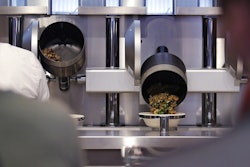As the manufacturing industry grows, customers require more products in a shorter time span to meet demand. To remain competitive in their markets, manufacturers look to reduce costs and increase production in factories. The advancements in automation introduced in the era of Industry 4.0 can help manufacturers optimize assembly lines to deliver high-quality products to customers quickly and efficiently.
A fully automated production line creates a final product from raw materials with little to no human interaction. Hard and soft robots, and programmable automation are the three main types of automated systems that allow a production line to run efficiently with little human input. These systems are found throughout the assembly line to complete different tasks effectively, including assembly, packing and collecting data to monitor production.
Why Automate?
Before integrating automation into production lines, manufacturers must decide why they require automated processes, to ensure they get the best return on investment. For example, manufacturers may have customers that require bespoke products that older machines cannot produce efficiently. Manufacturers can meet customer expectations by accurately assembling products with increased automation. This also helps achieve optimal equipment effectiveness (OEE).
Once manufacturers know why they want to automate their factory, they must decide which processes would benefit most from the upgrade. Integrated automation can increase production at every stage of the supply chain. Robots can load original materials onto conveyer belts and move the product between stations. Stations can also use robots to assemble different components, depending on specific end-of-arm tooling. At the end of the production line, robots can efficiently pack products into cases for delivery.
Each stage of the supply chain requires different technology to best complete its repetitive tasks. Delicate tasks, such as packing fragile parts, require soft robots that can handle products with ease. During manufacturing, visual sensors can detect defective products to help maintain quality and ensure manufacturers only deliver the best products to customers.
Connected Devices
Machines connected by the Internet of Things (IoT) often communicate during production. This streamlines the production line to ensure efficient production. Computers collect, process and store all data from these machines, which is then relayed to plant managers, who can use this data to optimize business strategies in future production. Industrial computers are therefore essential in automated production lines to create smart factories.
As well as optimizing the supply chain, manufacturers can integrate automation into administrative processes. Relevant data collected by sensors can be sent to data centers where it is stored. Manufacturers can revisit this data at later stages and use it to optimize future projects.
Retrofitting
Manufacturing new products on an existing assembly line is a frequent challenge that plant managers face. It is a common myth that factories made up of older equipment cannot automate their processes due to compatibility issues and lack of technical advancement. However, plant managers can easily integrate automation into their factories by retrofitting equipment.
Retrofitting is often misconceived as a step backward as it involves replacing older components with more advanced equipment, rather than replacing the whole system. When completed correctly, retrofitting extends the life of equipment and reduces the need for future maintenance, improving cost and energy efficiency in the factory.
For example, some robots on an automated supply chain may only need new end-of-arm tooling and programming to alter its actions and assemble a new product. This reduces the cost of creating separate assembly lines for each product in a factory and increases overall production rates.
Industry 4.0 developments help merge real and virtual factories by using sensors and web connectivity. With connected assembly lines, factories can control themselves to optimize processes. For example, machines and products can communicate through data collected by sensors to determine what orders should be completed first on production lines.
When optimizing manufacturing processes, plant managers can invest in advanced technology to efficiently meet demand and manage time and cost-effectively. To ensure the best return on investment when using this equipment, manufacturers should apply Ford’s principles that optimized his factory over a century ago.
Jonathan Wilkins is the marketing director at obsolete automation parts supplier, EU Automation.























